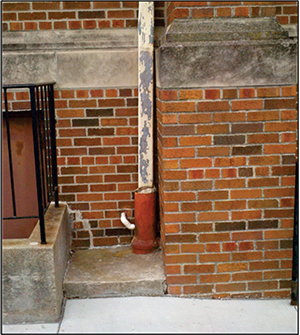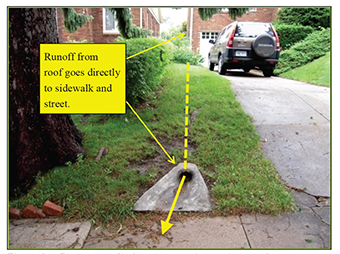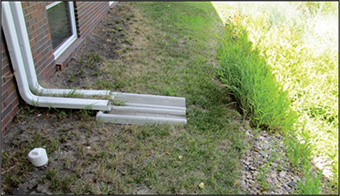G2186
Stormwater Management:
Disconnecting Downspouts and Impervious Surfaces
This NebGuide provides an overview of several methods to eliminate direct connections between downspouts and/or impervious surfaces and municipal storm drain systems to reduce the amount of stormwater runoff and pollutants that leave a property.
David P. Shelton, Extension Agricultural Engineer
Steven N. Rodie, Landscape Horticulture Specialist
Kelly A. Feehan, Extension Educator — Horticulture
Thomas G. Franti, Extension Surface Water Management
Engineer
Katie A. Pekarek, Extension Educator — Stormwater Management
- What Is Disconnection?
- Disconnecting or Redirecting Downspouts
- Disconnecting Impervious Surfaces
- Other Considerations
- Summary
- Resources
|
Stormwater management in both urban and rural areas is a current focus across the United States. Stormwater runoff is water from rain or melting snow that does not soak into the ground. It flows from rooftops, streets, parking lots, sidewalks, driveways, bare soil, sloped lawns, and other areas. As it flows, this runoff can collect and transport soil particles, pesticides, fertilizer, oil and grease, metals, nutrients, bacteria, leaves and grass clippings, litter, animal wastes, and other pollutants.
Street gutters, storm drains, and other surface drainage systems are designed to rapidly convey runoff to a nearby stream, river, or other water body. Unlike sanitary sewers, and contrary to popular belief, most stormwater from storm drains (storm sewers) is not treated at a wastewater treatment plant; instead it flows directly to the receiving water body. In fact, it is illegal in most municipalities to direct stormwater into the sanitary sewer, which would go to a wastewater treatment plant.
As citizens, we have a responsibility to reduce the effects of stormwater runoff on our environment. Under provisions of the Federal Clean Water Act, towns and cities with populations greater than 10,000 are required to reduce the amount of pollution contained in stormwater runoff as well as reduce and better manage runoff volumes. All of us need to take an active role in protecting water quality.
Individuals can do a number of things to reduce both pollutant loading and stormwater runoff from homes, businesses, lots, and other areas. Disconnecting downspouts and impervious surfaces are examples. This can help reduce municipal infrastructure costs and improve water quality.
What Is Disconnection?
Disconnection helps ensure that runoff water from roofs, downspouts, driveways, patios, and other impervious surfaces does not have a direct route to a sanitary sewer, storm drain, or water body. Instead, runoff is directed to one or more of the following: a rainwater harvesting system where it is temporarily stored for later use; a specifically designed pervious area where it infiltrates into the soil; or across a vegetated surface where it is filtered prior to reaching a drainage system or water body.
Disconnecting or Redirecting Downspouts
At one time, it was common to route building downspouts directly into the sanitary sewer system (Figure 1). This practice is now strongly discouraged and generally illegal, although sometimes still present, particularly in older sections of some cities. Municipalities have made a concerted effort to eliminate these connections, often using smoke or dye to detect them.
Another common practice is to route downspouts so they discharge onto a driveway or other impervious surface (Figure 2). Typically, this runoff water then flows to the street, into a storm drain, and to a water body. Any pollutants collected by the runoff water are carried directly to the receiving water body.
Simply redirecting a downspout so it discharges onto a lawn, mulched shrub bed, or other planted area instead of an impervious surface such as a driveway can greatly reduce the amount of water and pollutants that leave a property and subsequently reach a water body. Besides the filtering benefits of the runoff flowing through the landscape vegetation, additional benefits are derived from the runoff infiltrating into the soil. However, because water is a valuable resource, it is preferable if the runoff water can be directed to a designed rainwater harvesting system where it is collected and used or allowed to infiltrate under controlled conditions. (Refer to NebGuide G2148, Stormwater Management: Rainwater Harvesting in Residential Landscapes for descriptions of various rainwater harvesting systems.)
Rain barrels and cisterns (Figure 3) are two common rainwater harvesting methods that collect and hold roof runoff for later use. Rain barrels are commercially available or adapted from existing barrels, and typically have a capacity of 50 to 100 gallons. The collected water is primarily used for watering landscape or container plants. Cisterns generally have a capacity of 100 gallons or more and can be built aboveground or belowground. Depending on the volume available and other factors, water from a cistern can be used for potable or non-potable purposes. Non-potable uses include landscape or container plant irrigation, car washing, and toilet flushing. However, the use of rainwater in a domestic plumbing system, even for toilet flushing, requires some form of approved treatment. Appropriate filtering and disinfection are required for rainwater to be suitable for potable uses like drinking, cooking, or bathing.
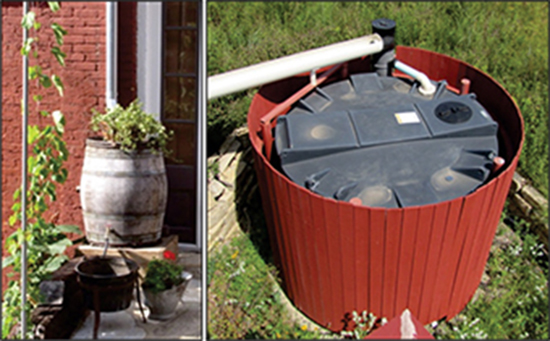 |
| Figure 3. Rain barrel constructed from a repurposed whiskey barrel (left) and a 3,000 gallon cistern (right). |
A major limitation of cisterns and rain barrels is that they can only hold a limited amount of water. Thus, provisions must be made to handle any water that overflows. For example, the runoff from only about 80 square feet (8 feet by 10 feet) of roof area will fill a 50-gallon rain barrel during a 1 inch rain. Or, 1 inch of rain falling on a 1200 square foot roof will generate approximately 750 gallons of water — enough to fill fifteen, 50-gallon rain barrels. Ideally, overflow is directed to additional storage containers, to a permeable surface where it infiltrates into the soil, or to other best management practices (BMPs) that further enhance water quality and use.
Infiltration practices suited for management of rain barrel or cistern overflow, or to receive water directly from a downspout include rain gardens, bioretention basins, swales, drywells, and infiltration trenches.
Rain gardens and bioretention basins (Figure 4) are ornamental landscape areas planted with native or adapted deep-rooting vegetation in a shallow depression, typically 4-12 inches deep. They are designed to hold water for a short period of time, generally 48 hours or less, before the water infiltrates into the soil. They are typically located where roof or other surface runoff can be easily directed to them, but at least 10 feet away from building foundations or basements to avoid water problems. The plants and amended native soil in a rain garden facilitate infiltration and evapotranspiration, as well as provide pollutant filtering. Bioretention basins use similar plantings, but are typically larger and contain an underdrain system and valve for more controlled infiltration from larger surface areas.
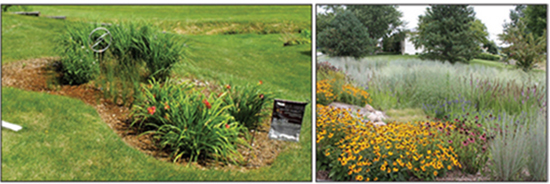 |
| Figure 4. Rain garden (left) and bioretention basin (right). |
A bioswale (Figure 5) is a broad, shallow, gently sloped, vegetated channel designed to convey, filter, and infiltrate stormwater. Bioswales slow runoff water velocity, trap sediment and other contaminants, promote infiltration, and help direct runoff to additional BMPs, storm drain systems, or water bodies. Bioswales are sometimes used adjacent to streets in place of curbs and gutters.
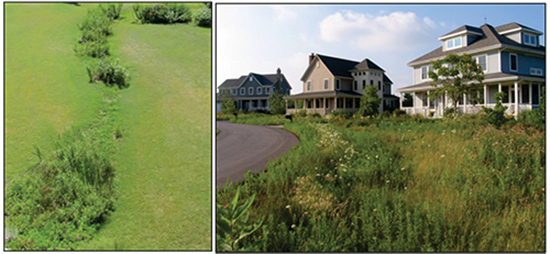 |
| Figure 5. Bioswales. Streetside bioswales (right) can sometimes be used in place of a system of street curbs, gutters, and underground storm drains. |
Drywells are perforated, permeable underground structures or buried volumes of gravel that store and then slowly release collected rainwater into the surrounding soil.
Infiltration trenches (Figure 6) are similar to drywells, except they are long and narrow instead of circular or rectangular and generally have greater capacity. Typically, infiltration trenches are constructed using plastic chambers similar to those used for septic system drain fields or a perforated distribution pipe surrounded by washed and graded gravel. Water storage is provided within the chamber or in the gravel pore space. Infiltration into the surrounding soil occurs through both the sides and bottom of the trench.
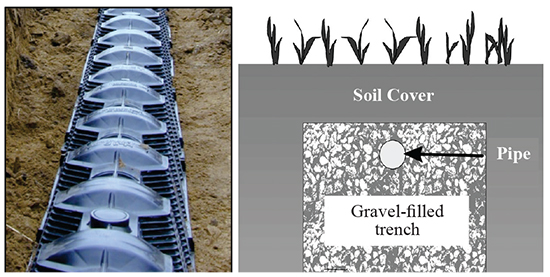 |
| Figure 6. Infiltration trenches: plastic chambers (left); and perforated pipe and gravel. |
Because each situation is unique, it is not possible to provide detailed instructions for rerouting downspouts into a rain barrel, cistern, or other rainwater harvesting practice. However, this typically involves:
- Planning where the practice is to be located, how and where the collected water will be used, where the existing downspout(s) will need to be cut, what fittings will be required to redirect the downspout, cost, etc.
- Gathering tools and supplies such as a hacksaw, drill, tape measure, screwdrivers, gloves, safety glasses, downspout fittings, additional piping, and other items.
- Cutting and removing the existing downspout pipe and fittings.
- Installing the rainwater harvesting practice, new fittings, and any other components needed to direct the water to the new location.
- Securely capping or plugging the remaining pipe if it previously was routed into a sanitary or combined sewer system.
Disconnecting Impervious Surfaces
It is generally more difficult to reroute the runoff from impervious surfaces than it is to disconnect or reroute downspouts. These surfaces are often sizable, for example a driveway or parking lot. The water running off them is generally diffuse rather than concentrated as from a downspout. Also, these surfaces are often an integral part of the property. Still, several of the storage/infiltration systems suitable for downspout disconnection can be adapted for disconnecting impervious surfaces.
A good way to determine how impervious surfaces can be disconnected is by observing water flow during a rainstorm (when lightning is not occurring). Consider the following questions, and if possible, document information on a sketch or aerial photo of your property: Does water soak into the ground quickly or does it puddle in places? Where does it flow off the lawn, driveway, or other areas? Note how far it is to the nearest street gutter, storm drain, stream, or other water body. Note whether runoff flows onto your property from adjacent lots, streets, or stormwater systems. Be sure to observe during more than one rain event to have a better understanding of runoff flow during different size storms.
Once you have a good idea of how water flows across and off of your property, you can develop plans for how to control and redirect the runoff so less leaves the property. Some options are:
- If feasible, replace impervious surfaces with trees, shrubs, mulched planting beds, groundcover plantings, or permeable alternatives such as porous pavement, permeable pavers, or reinforced areas of grass (Figure 7). This is often referred to as de-paving.
- Construct a small berm or swale downslope of a patio or other impervious surface to help direct the runoff to a rain garden, bioswale, or other vegetated area.
- Use site grading to direct rainwater away from impervious surfaces and onto vegetated areas.
- Plant and maintain dense, healthy plant cover, especially on slopes. Shrub and tree leaves intercept and slow rainfall and their roots enhance infiltration and minimize soil erosion.
- Increase the use of properly mulched landscape beds to reduce large expanses of turfgrass, thus potentially reducing irrigation and pesticide inputs and associated runoff pollution.
- Avoid planting high maintenance turfgrass on steep slopes, in deep shade, or in areas not conducive to healthy turf growth. Instead, select native or adapted turfgrasses or other ground covers.
- Practice proper management of existing turfgrass to maintain healthy, vigorous growth to help increase filtering and infiltration of runoff water. This includes proper mowing height and frequent core aeration along with top dressing with compost to increase soil organic matter. Base fertilizer application on soil tests, and limit pesticide use only to control identified problems.
- On newly developed sites, stockpile and protect topsoil, minimize site compaction whenever possible, and spread/incorporate the stockpiled topsoil into finished grades prior to planting. When existing landscape areas are renovated, amend all disturbed soils with several inches of compost and incorporate as deeply as possible. In either case, maximizing the infiltration rates of soils on a site prior to planting will enhance runoff management as well as support healthier plants.
- Although not a practice homeowners can undertake, curb cuts can sometimes be installed in parking lots or streets to direct runoff water into a rain garden or bioretention basin, often in the public right-of-way (Figure 8).
- Likewise, in new developments, curbs and gutters can sometimes be eliminated during the design process, thus reducing construction costs. Street runoff water then flows into an adjacent bioswale designed to slow, filter, infiltrate, and convey the runoff. Property owners interested in curb cuts or developments without curb and gutter systems should contact municipal officials to determine the feasibility of these practices.
 |
| Figure 7. Permeable pavers (left); porous concrete and close-up (center); grass paving grid (right). |
 |
| Figure 8. Curb cuts into parking lot island (left) and rain garden in street right-of-way (right). |
|
Other Considerations
Several precautions or other factors may need to be considered when disconnecting downspouts or impervious surfaces, including:
- Contact Diggers Hotline or One Call (811 or www.ne-diggers.com) utility locating service before digging. This will help protect you from injury and/or liability if an underground utility is damaged.
- Verify that soil infiltration capacity is adequate for the practice that will be installed. (Refer to NebGuide G1472, Residential Onsite Wastewater Treatment: Conducting a Soil Percolation Test for information on determining soil infiltration rate.)
- Conduct soil tests and add any needed amendments prior to plant installation to improve soil infiltration and help ensure suitable plant establishment and growth.
- Clean gutters and downspouts twice a year to help reduce clogging and overflows.
- Extend downspouts at least 5 feet from building foundations to help avoid water seepage into basements. Use splash blocks or other means of reducing erosion (Figure 9).
- Grade landscaped areas adjacent to buildings to slope away from building foundations. A slope of 2 percent (approximately 2 inches of drop per 8 feet of horizontal distance) will ensure positive drainage of vegetated and mulched surfaces. Positive drainage on paved surfaces adjacent to buildings can be achieved with slopes of 0.5 percent to 1 percent. Landscaped areas and paving can settle over time, so periodically check to verify that water is not collecting where it can cause damage or be a nuisance.
- Verify the location of any septic systems (septic tank, sewer lines, drainfields, etc.) on the property. Do not locate a rain garden, bioretention basin, bioswale, drywell, or infiltration trench within 50 feet of the septic tank or drainfield. Do not direct downspout discharge toward any component of the septic system.
- Do not locate any infiltration-type practice in areas of shallow groundwater.
- Evaluate the impact of any changes to make sure that runoff is not directed toward neighboring properties or will not adversely affect existing plants or structures.
Summary
Some benefits of disconnecting downspouts and impervious surfaces include:
- Decreased volume and velocity of stormwater runoff leading to decreased flooding potential and fewer pollutants entering water bodies.
- Potential reduction of municipal stormwater management and associated infrastructure costs.
- Increased soil moisture for reduced irrigation requirements as well as enhanced plant vigor, hardiness, and drought tolerance.
- Potential groundwater recharge and/or more stable base flows in streams and rivers.
Resources
Visit the http://water.unl.edu/stormwater website for publications, scheduled activities, and other stormwater management information.
This publication has been peer reviewed.
Visit the University of Nebraska–Lincoln Extension Publications website for more publications.
Index: Water Management – Water Quality
and
Lawn & Garden – Water Management
Issued April 2013
